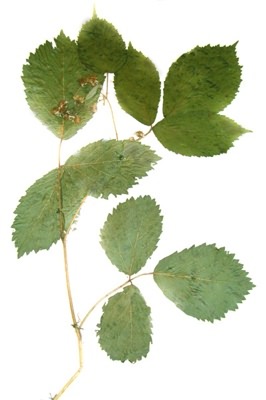Relatives
Rubus caucasicus Focke - Caucasian raspberry.
Taxonomic position:
Family: Rosaceae Juss.; genus: Rubus L.Morphology and biology.
Perennial bush up to 2 m in height. Year-old and floriferous shoots are without a grey pubescense, covered by hairs, reddish stalked glandular hairs and thin long spines. Spines are strongly bent from above, amplate from the basis. Leaves consist of three leaflets, sometimes - five leaflets, dense, glabrous from above, covered by white tomentose down from below. Upper leaflet is ovate with the pointed top and with heart-shaped sinuate basis. Lateral leaflets sometimes are 2-lobate. Flower-bearing shoots are pubescent, thckly clothed with glandulose hairs and infrequent curved spines. Inflorescences are prolate, multiflowers, frequently - little bit curved. Flowers are rather large. Calyx lobes at fruits are adpressed, sometimes deflexed to bottom. Petals are large, divaricate. Stamens hardly reach top of columns. Gynaeciums are downy. Blossoms in May, fructifies in July.Distribution.
Common difstribution: Caucasus. In terrain of the former USSR: Caucasus.Ecology.
In woods. From inferior up to top mountain belts.Use and economic value.
Alimentary berrylike.References:
Cherepanov S.K. 1995. Vascular plants of Russia and allied countries (in frame of the former USSR). St-Petersburg. 990 p. (in Russian).Grossgeim A.A. Flora of Caucasus. М., Л., 1952, Т.5, p. 55-56.
Shishkin B.K., Yuzepchuk S.V., ed. 1941. Flora of the USSR. Vol. X.


